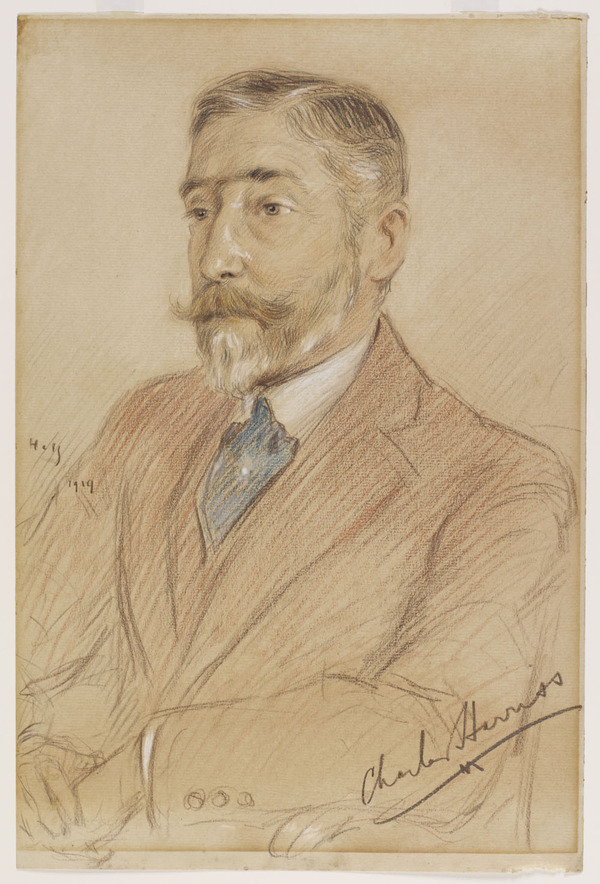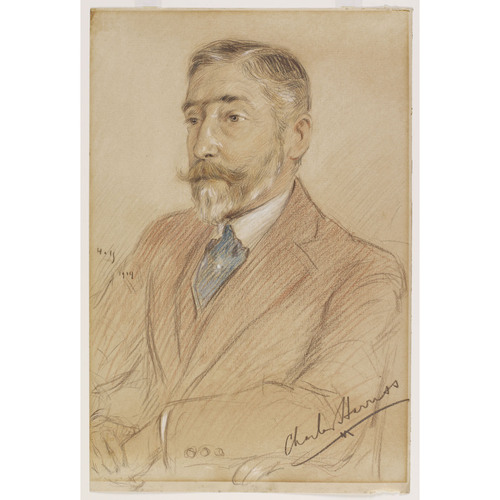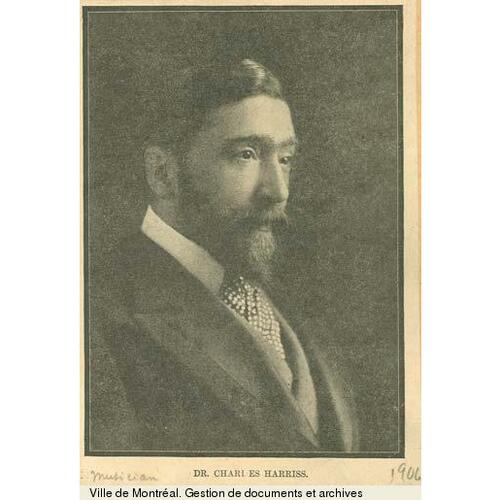HARRISS, CHARLES ALBERT EDWIN, musician, impresario, and educator; b. midnight 16–17 Dec 1862 in London, England, son of Edwin Harriss, an organist, choir master, and concert manager, and Elizabeth Duff; m. 15 Sept. 1897 in Cobourg, Ont., Ella Frances Shoenberger, née Beatty (d. 1924), daughter of Dr John Beatty, a former professor at Victoria College there; they had no children; d. 31 July 1929 in Ottawa and was buried in Cobourg.
Charles Harriss was an ardent and outspoken British imperialist whose lifelong quest was to establish British musical excellence in Canada and in other parts of the empire. His persuasive personality, enthusiasm, organizational abilities, and varied musical talents, combined with his ambition, grandiose vision, and prominent social standing ensured that the majority of his projects were realized.
Harriss first studied music with his father, and then was educated in the English cathedral tradition as an Ouseley scholar at St Michael’s College, Tenbury, in the early or mid 1870s. After his initial church appointment as choir director at St John’s in Wrexham, Wales, he was apprenticed with Frederick Davis of Reading, near London, before becoming parish organist in Welshpool, Wales, in 1880. When Susan Agnes Bernard*, wife of Canadian prime minister Sir John A. Macdonald* asked the prominent British musician Sir Frederick Arthur Gore Ouseley to secure an organist for the Church of St Alban the Martyr in Ottawa, Harriss auditioned and obtained the position. He arrived in Ottawa in December 1882. He moved to Montreal the next year to become organist and choir master at Christ Church Cathedral, where he remained until 1886, when he succeeded his father in the same positions at the Church of St James the Apostle, also in Montreal; he would hold the posts to 1894. During his father’s sojourn in Montreal from 1883 to 1885, the Harrisses gave joint recitals, taught privately, conducted choral groups, and managed concerts.
From around 1890 to 1898 Harriss was the Canadian agent for Nicholas Vert, a leading European impresario based in London. In this capacity he organized North American tours for such artists as Sir Charles Santley in 1891 and Emma Albani [Lajeunesse] in 1896. During this period he composed mainly religious and salon pieces which were published by leading Canadian, English, and American companies, and two major works for solo, chorus, and orchestra, namely Daniel before the king, a dramatic sacred cantata, and Torquil, based on a Scandinavian legend. The first work, written in 1884 and published by the American firm G. Schirmer in 1890, was premiered on 18 April 1890 by the Montreal Philharmonic Society conducted by Guillaume Couture*. Torquil, published as a piano-vocal score by the Toronto firm Whaley, Royce and Company Limited in 1896, was first performed on 22 May 1900 by Frederick Herbert Torrington*’s Festival Chorus, accompanied by the Boston Festival Orchestra, at Toronto’s Massey Music Hall. His larger choral works show the influences of the oratorio tradition and of such composers as Mendelssohn and Wagner.
Harriss’s focus on the production of large-scale works was facilitated by his marriage in 1897 to Ella Beatty, the widow of wealthy Ohio manufacturer George K. Shoenberger, who helped to obtain patronage and provide the necessary capital for his many ventures. In 1900 she bought Earnscliffe, Lady Macdonald’s Ottawa residence, for $15,000. Notwithstanding her lavish renovation of the house, she maintained the Macdonalds’ atmosphere in a number of rooms. She directed several musical associations in Canada. Their many prominent friends included Lady Minto, wife of Governor General Lord Minto [Elliot*]. Lady Minto regularly corresponded with Charles Harriss for over 20 years and he dedicated his Festival mass to her. This work was premiered at Notre-Dame Basilica in Ottawa in 1902 and included the 16-year-old Éva Gauthier* as one of the soloists.
In 1903 Harriss was appointed by McGill University honorary director of a system of musical examination centres which had been set up by McGill in conjunction with the Associated Board of the Royal Schools of Music in London. This appointment led to his being chosen the following year as the first director of the McGill Conservatorium of Music; he would hold the post to 1907. Harriss wanted to establish British standards of music education and examinations in Canada. His main objective was to promote musical reciprocity within the empire. Many Canadian music teachers considered the introduction of the associated board a one-sided affair, but its examinations were successfully implemented in spite of their protest.
Harriss’s mission carried over into other activities, such as organizing concerts and conducting. He planned the Cycle of Music Festivals of the Dominion of Canada, featuring a British choral and orchestral repertoire conducted by Sir Alexander Campbell Mackenzie and performed by choruses in 15 cities across Canada. In 1905, with the sponsorship of Mackenzie, he became the first colonial musician to receive the Lambeth degree d.mus., conferred by the archbishop of Canterbury. The next year he set up a Montreal choir, the Philharmonic Union, which performed his “choric idyll” Pan with the Pittsburgh Orchestra and in 1907 premiered his ballad The sands of Dee. During these years he extended his musical reciprocity to England, starting in 1906 with the Canadian Music Festival in London, which featured a performance of Pan with Pauline Donalda [Lightstone*], and continuing in 1907 with the Empire Day Concerts there. In 1908, also in London, Harriss conducted his second mass, Coronation mass Edward VII, which had premiered in Saint John in 1903; it was performed by the Sheffield Choir and the London Symphony Orchestra, with Gauthier again as one of the soloists. The same year he organized the Canadian tours of Sir John Frederick Bridge and of the Sheffield Choir under Henry Coward. His last Canadian tour featured His Majesty’s Scots Guard Band in 1922. In 1909 he had set up the 4,500-voice Imperial Choir in London; it formed the basis of the mammoth 10,000-voice choir which performed at the Empire Day Concert in 1911 and as part of the peace celebrations at Hyde Park in 1919. He prepared the Musical Festival of the Empire, a musical tour of Australia, New Zealand, South Africa, Canada, and the United States which was held in 1911. Two years later he took 2,000 members of the Imperial Choir to perform at the International Exhibition in Ghent, Belgium. His last major undertaking was as music director of the British Empire Exhibition in Wembley in 1924. He was offered a knighthood for his contribution to the empire, an honour which he surprisingly refused.
This indefatigable champion of closer cultural ties with Britain was described by the English musical scholar Percy Alfred Scholes as “a veritable musical Napoleon – always engaged in a tonal campaign somewhere at earth’s service.” Harriss received regular coverage of his compositions, recitals, and projects in the press and he used his extravagantly vocal public persona to create, organize, and invigorate musical institutions and concert activity across Canada and abroad. He successfully composed in the idiom of his time. Although his works did not survive him, they were published and probably performed to a greater extent than those of most of his Canadian contemporaries.
[About half of Charles Albert Edward Harriss’s 125 known compositions have not been located, including two of his major works: The admiral, a comic opera composed around 1902, and Canadian fantasie for chorus and orchestra, which premiered in Ottawa in 1904. A detailed catalogue of Harriss’s works can be found in the appendix of the author’s ma thesis. The bulk of his manuscript scores, along with correspondence, the first chapter of a typescript autobiography, programs, and other materials, are held in the Harriss coll. at MUA, MG 3021. The Music Div. of the National Library of Canada, Ottawa, holds 13 volumes containing compositions, printed programs, scrapbooks, and miscellaneous items (MUS 11). The collection in the NA (MG 30, D15) includes correspondence, programs, and pamphlets. The most extensive analysis of Harriss’s compositions appears in John Beckwith, “Choral music in Montreal circa 1900: three composers,” Univ. of Toronto Quarterly, 63 (1994): 504–17. n.t.]
The Canadian musical heritage, ed. Elaine Keillor et al. (23v. in 18 to date, Ottawa, 1983– ). “Dr. Charles Harriss,” Musical Times (London), 50 (1909): 225–29. Encyclopedia of music in Canada (Kallmann et al.). A. C. Mackenzie, A musician’s narrative (London, [1927]). Musical Canada (Toronto), November 1908. The musical red book of Montreal . . . , ed. B. K. Sandwell (Montreal, 1907). Tancrède Trudel, “Charles A. E. Harriss,” Le Canada artistique (Montréal), 1, no.12 (décembre 1890): 193–94. Nadia Turbide, “Charles Albert Edwin Harriss: the McGill years” (ma thesis, McGill Univ., 1976).
Cite This Article
Nadia Turbide, “HARRISS, CHARLES ALBERT EDWIN,” in Dictionary of Canadian Biography, vol. 15, University of Toronto/Université Laval, 2003–, accessed December 20, 2025, https://www.biographi.ca/en/bio/harriss_charles_albert_edwin_15E.html.
The citation above shows the format for footnotes and endnotes according to the Chicago manual of style (16th edition). Information to be used in other citation formats:
| Permalink: | https://www.biographi.ca/en/bio/harriss_charles_albert_edwin_15E.html |
| Author of Article: | Nadia Turbide |
| Title of Article: | HARRISS, CHARLES ALBERT EDWIN |
| Publication Name: | Dictionary of Canadian Biography, vol. 15 |
| Publisher: | University of Toronto/Université Laval |
| Year of publication: | 2005 |
| Year of revision: | 2005 |
| Access Date: | December 20, 2025 |





